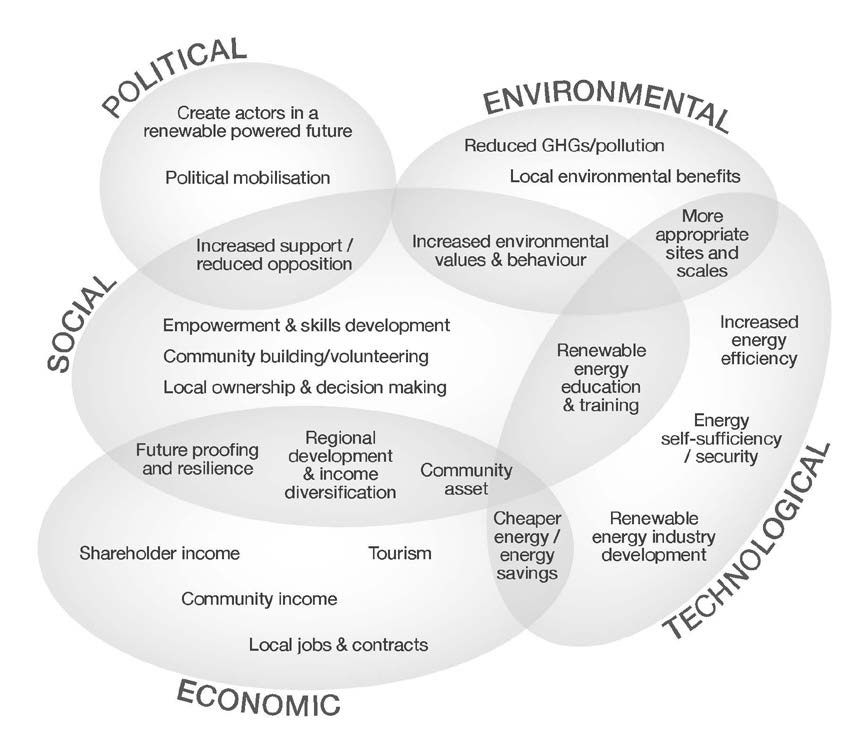When we think of a community in the context of a local energy project, what are the optimal benefits the local community might receive? I argue the best outcome is to deliver benefits that reflect the real desires and motivations of the local community.
This article in ReNEWS with the title “Scottish project ‘perfect example’ of community benefits” caught my eye. It describes the Kype Muir Wind Farm, developed by Banks Renewables who are based in Hamilton (Scotland).
This very large, private development, seemingly delivered the minimum level of community benefit - £5,000 per MW for a 155 MW development makes for £775,000 each year. So in that regard they are perfectly on-target for achieving the minimum level per the guidelines. I would say far from perfect.
The only other local benefits described are involving the local community (in some unspecified way) and prioritising local contractors “wherever possible”.
So in what way is it justified to say this project is a ‘perfect example’ of community benefits? It is very hard to say. For starters, we do not know what criteria were deemed to be important. At a superficial level it appears that merely achieving yearly community benefit payments of £5,000 per MW while also doing (required as part of planning anyway) community engagement plus making nice sounding statements about local contractors are the three things that are important to Michael Matheson, Cabinet Secretary for Net Zero, Energy and Transport (Scottish Government).
Deep thinking about community benefits
My colleague at Community Power Agency, Jarra Hicks, has thought very deeply about motivations and impacts of community energy, choosing this topic for the thesis of her PhD.
[http://hdl.handle.net/1959.4/60127](http://hdl.handle.net/1959.4/60127)
Building on earlier work with Nicky Ison, the other co-founder of Community Power Agency, Jarra reviews the literature on community energy, including revisiting the excellent STEEP analysis of motivations found in The Home Energy Handbook.

There is far too much in Jarra’s thesis to fully unpack in a short blog post, however she takes the approach of conceptualising community energy as a form of social enterprise and diverse economies. She then goes on to research/explore how social enterprise design plays out “in the context of multiple, sometimes competing, motivations”.
Specifically, she digs into three aspects of enterprise design:

This is all very academic for sure, but for someone who gives much of their time to community energy, like me, it is fascinating reflective material that highlights the importance of consciously designing our social enterprises in a way that maximises the chance of achieving the outcomes we seek to achieve. Or, put another way, the design of our (social) enterprises is important; if there are certain outcomes we want to achieve, we would do well to ensure the enterprise is designed accordingly.
Web diagrams
One of the best aspects in the thesis is the use of ‘spider diagrams’. These are used to explicitly identify the characteristics being rated and to display multiple projects on a single diagram. Here is an example describing the extent to which the four case studies utilised diverse economic arrangements. The choice of which criteria should comprise the ‘legs’ (or axes) is very much a choice made by Jarra, the author. The fact this was a choice to-be-made highlights why this methodology is so helpful - it makes explicit the criteria by which the projects are being rated and compared.

Look at Shapinsay - it has a large footprint, but scores nil on two of the eight metrics. Contrast with Hepburn which is much more of an ‘all rounder’, also having the biggest footprint of these projects. I wonder where Kype Muir would land with a similar analysis against these criteria? Would it score as well as Skye?
What perfect?
Often when people talk about community energy, they do so along pre-determined, inflexible and narrow lines. In the Scottish (and UK) context, “community benefit” has become fairly confused with community benefit payments. As Jarra points out in her thesis, the common frame for research into community energy is through the lens of socio-technical transitions theory. I would say this is the most common frame in most contexts, not just in academic research.
Within existing literature, CORE is most commonly analysed through the lens of socio-technical transitions theory, which positions it as a ‘niche’ activity of grassroots innovation. This literature analyses CORE for its current and potential contribution to energy systems change. However, these analyses come from a “fundamentally technologically centered and marketdriven model of system change” that do not adequately take into account the social and relational aspects of CORE or the role of power and politics in change processes (Chilvers and Longhurst 2016, p.588; also Veelen 2017). As such, they tend to downplay community dynamics and local-level outcomes of CORE in favour of an analysis of contributions to larger systems transformation. As elaborated by Veelen (2017, p.3) socio-technical analysis focuses on a role of elites and technology, “offering little in the way of exploring the heterogeneity of motivations, visions, and social relationships within niches”. As a result, this perspective can overlook a range of local outcomes and impacts and, thus, undervalue the role that these small, diverse community-led social enterprises can play. For these reasons I have chosen to apply different analytic frames (diverse and generative economies) in this thesis.
Jarra Hicks - Thesis, 2018, p.28
I could not agree more. It is better to think in broader terms than just the technology centred and market driven model of system change. Yes, there is something in that way of thinking, but there is equal validity in other ways of thinking. This is about the strength that diversity often brings and the problems that come with lack of diversity.
Community-BenefitsCommunity-EnergyCommunity-Power-AgencyJarra-HicksNicky-IsonKype-MuirMichael-MathesonScottish-GovernmentSocial-Enterprise-DesignWeb-DiagramEnergy